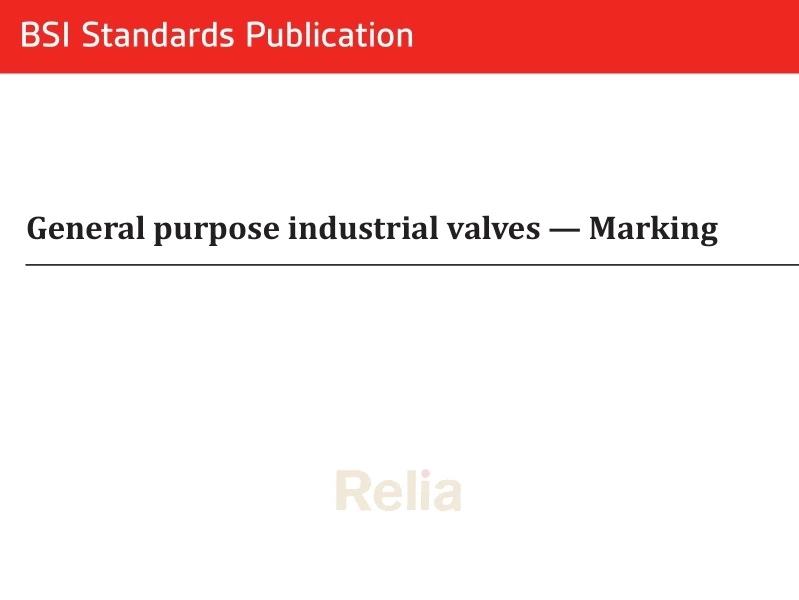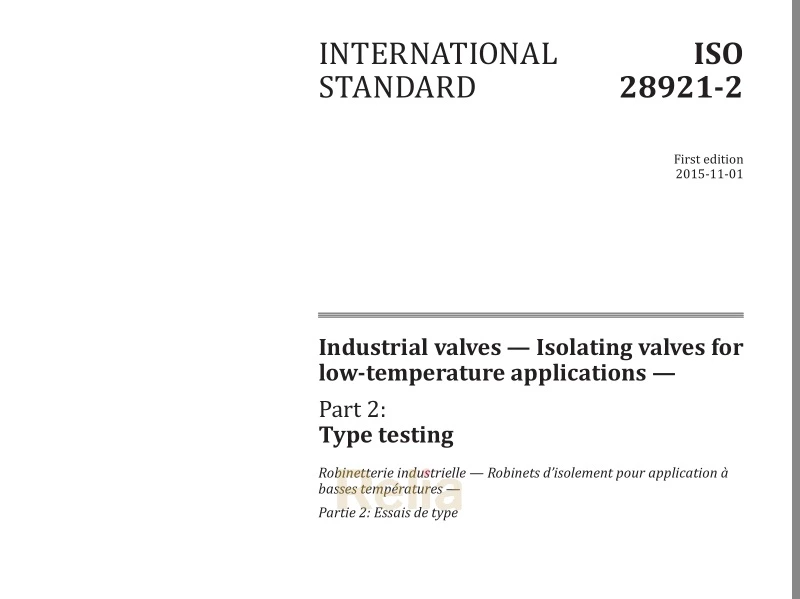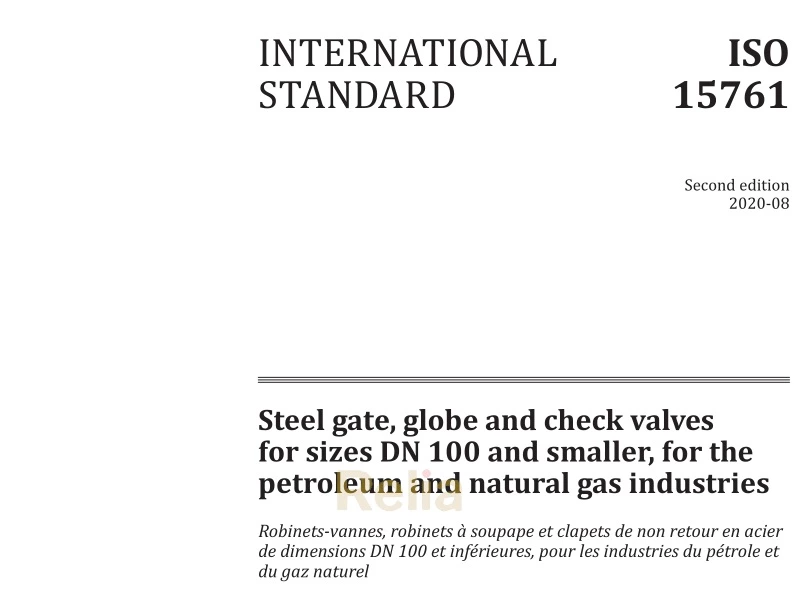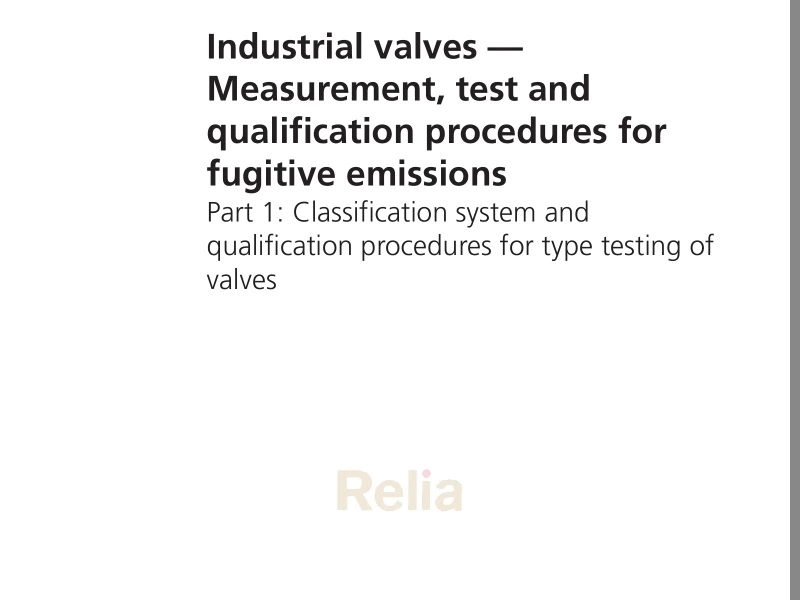ISO 10434: Bolted bonnet steel gate valves for the petroleum, petrochemical and allied industries
ISO 10434 specifies the requirements for a heavy-duty series of bolted bonnet steel gate valves for petroleum refinery and related applications where corrosion, erosion and other service conditions can indicate a need for full port openings, heavy wall sections and large stem diameters.
ISO 10434 sets forth the requirements for the following gate valve features:
— bolted bonnet;
— outside screw and yoke;
— rising stems;
— non-rising handwheels;
— single or double gate;
— wedge or parallel seating;
— metallic seating surfaces;
— flanged or butt-welding ends.
ISO 10434 covers valves of the nominal sizes DN:
— 25; 32; 40; 50; 65; 80; 100; 150; 200; 250; 300; 350; 400; 450; 500; 600;
corresponding to nominal pipe sizes NPS:
— 1; 1¼; 1½; 2; 2½; 3; 4; 6; 8; 10; 12; 14; 16; 18; 20; 24;
applies for pressure Class designations:
— 150; 300; 600; 900; 1 500; 2 500;
and applies for pressure PN designations:
— 16, 25, 40, 63, 100, 160, 250 and 400.
5 Design
5.1 Body wall thickness
5.1.1 A valve body schematic is shown in Figure 1.The minimum body wall thickness, Tm, at the time of manufacture shall be as given in Table 1, except as indicated in 5.1.2 for butt-welding valve ends. Additional metal thickness needed for assembly stresses, stress concentrations, and shapes other than circular shall be determined by individual manufacturers, since these factors vary widely.The body inside diameter (Figure 1, key 3)shall not be less than that specified in Table 6 for the body seat.
Table 1 —Minimum wall thickness for body and bonnet
| PN designation | 16 | 25 and 40 | 63 and 100 | 160 | 250 | 400 | Nominal size NPS | |||
| Class designation | 150 | 300 | 600 | 900 | 1500 | 2500 | ||||
| Nominal size DN | Minimum wall thickness Tm (mm) | |||||||||
| 25 | 6, 4 | 6, 4 | 7, 9 | 12, 7 | 7, 7 | 12, 7 | 8, 1 | 15, 0 | 12, 4 | 1 |
| 32 | 6, 4 | 6, 4 | 8, 6 | 14, 2 | 8, 5 | 14, 2 | 9, 4 | 17, 5 | 14, 8 | 144 |
| 40 | 6, 4 | 7, 9 | 9, 4 | 15, 0 | 9, 7 | 15, 0 | 11, 4 | 19, 1 | 18, 3 | 112 |
| 50 | 8, 6 | 9, 7 | 11, 2 | 19, 1 | 9, 2 | 19, 1 | 13, 6 | 22, 4 | 22, 3 | 2 |
| 65 | 9, 7 | 11, 2 | 11, 9 | 22, 4 | 11, 2 | 22, 4 | 16, 9 | 25, 4 | 28, 2 | 242 |
| 80 | 10, 4 | 11, 9 | 12, 7 | 19, 1 | 13, 2 | 23, 9 | 20, 2 | 30, 2 | 34, 1 | 3 |
| 100 | 11, 2 | 12, 7 | 16, 0 | 21, 3 | 15, 8 | 28, 7 | 42, 0 | 35, 8 | 42, 0 | 4 |
| 150 | 11, 9 | 16, 0 | 19, 1 | 26, 2 | 22, 5 | 38, 1 | 61, 8 | 48, 5 | 61, 8 | 6 |
| 200 | 12, 7 | 17, 5 | 25, 4 | 31, 8 | 29, 1 | 47, 8 | 81, 5 | 62, 0 | 81, 5 | 8 |
| 250 | 14, 2 | 19, 1 | 28, 7 | 36, 6 | 35, 7 | 57, 2 | 101, 2 | 67, 6 | 101, 2 | 10 |
| 300 | 16, 0 | 20, 6 | 31, 8 | 42, 2 | 42, 4 | 66, 8 | 121, 0 | 86, 6 | 121, 0 | 12 |
| 350 | 16, 8 | 22, 4 | 35, 1 | 46, 0 | 49, 0 | 69, 9 | 140, 7 | —— | 14 | |
| 400 | 17, 5 | 23, 9 | 38, 1 | 52, 3 | 55, 6 | 79, 5 | 160, 4 | 16 | ||
| 450 | 18, 3 | 25, 4 | 41, 4 | 57, 2 | 62, 3 | 88, 9 | 180, 2 | 18 | ||
| 500 | 19, 1 | 26, 9 | 44, 5 | 63, 5 | 68, 9 | 98, 6 | 199, 9 | 20 | ||
| 600 | 20, 6 | 30, 2 | 50, 8 | 73, 2 | 82, 2 | 114, 3 | 239, 4 | 24 | ||
The wall thicknesses for PN 160, PN 250 and PN 400 have been taken directly from EN 12516-1.
5.1.2 The weld end preparation in butt-welding end valves (see 5.3.2)shall not reduce the body wall thickness to less than the values specified in 5.1.1 within a region closer than Tm to the outside surface of the body neck, measured along the run direction.
The transition to the weld preparation shall be gradual and the section shall be essentially circular through the entire length of the transition.Sharp discontinuities or abrupt changes in section in areas that infringe into the transition shall be avoided, except that test collars or bands, either welded or integral, are allowed.
In no case shall the thickness be less than 0, 77 Tm at a distance of 2 Tm from the weld end.
5.2 Bonnet wall thickness
The minimum bonnet wall thickness at the time of manufacture, except for the neck extension that contains the packing, shall be Tm as given in Table 1.For the neck extension, the local minimum wall thickness shall be based on the local diameter, e.g.the inside diameter of the stem bore or packing box bore, and shall be in accordance with Table 2.
5.3 Body dimensions
5.3.1 Flanged ends
5.3.1.1 Body-end flanges for PN designated valves shall comply with the dimensional requirements of EN 1092-1 and body-end flanges for Class designated valves shall comply with the dimensional requirements of ASME B16.5.
If valve-end flange bolt holes are specified by the purchaser to be other than those of the respective PN or Class flange standard, the manufacturer shall ensure that the resultant total flange bolting cross sectional area is at least as great as that of the bolting being replaced.
Table 2 —Minimum wall thickness for bonnet neck extension
| PN designation | 16 | 25 and 40 | 63 and 100 | 160 | 250 | 400 |
| Class designation | 150 | 300 | 600 | 900 | 1500 | 2500 |
| Bonnet neck extension inside diameter (mm) | Minimum wall thicknessa (mm) | |||||
| 15 16 17 18 19 | 2, 8 2, 8 2, 8 2, 9 3, 0 | 3, 0 3, 1 3, 2 3, 5 3, 8 | 3, 6 3, 6 3, 7 3, 9 4, 1 | 4, 2 4, 4 4, 5 4, 7 5, 1 | 5, 3 5, 6 5, 8 5, 9 6, 1 | 7, 6 7, 9 8, 2 8, 5 8, 9 |
| 20 25 30 35 40 | 3, 3 4, 0 4, 6 4, 8 4, 9 | 4, 0 4, 8 4, 8 4, 8 5, 0 | 4, 2 4, 8 4, 8 5, 1 5, 7 | 5, 2 6, 3 6, 5 7, 1 7, 5 | 6, 3 7, 1 8, 2 9, 7 10, 2 | 9, 2 11, 0 13, 1 14, 6 16, 4 |
| 50 60 70 80 90 | 5, 5 5, 6 5, 6 5, 8 6, 4 | 6, 2 6, 4 6, 9 7, 2 7, 4 | 6, 3 6, 8 7, 4 8, 1 8, 8 | 7, 9 8, 9 9, 9 11, 0 12, 0 | 11, 6 13, 4 15, 8 17, 4 19, 1 | 19, 8 23, 2 26, 5 30, 1 33, 2 |
| 100 110 120 130 140 | 6, 4 6, 4 6, 6 7, 1 7, 1 | 7, 7 8, 1 8, 6 8, 8 9, 2 | 9, 5 10, 3 10, 9 11, 3 12, 0 | 12, 8 14, 1 14, 9 16, 2 17, 3 | 20, 8 22, 9 24, 8 26, 5 28, 3 | 36, 7 40, 1 43, 5 46, 9 50, 2 |
| a See 5.2 | ||||||
5.3.1.2 Face-to-face dimensions for flanged end valves shall be as follows:
一 for PN designated valves, in accordance with IS05752, basic series 3, 4 and 5;
一 for Class designated valves, in accordance with ASME B16.10;
一 the tolerances for all face-to-face dimensions shall be in accordance with the note in Table 5.
5.3.1.3 Body-end flanges and bonnet flanges shall be cast or forged integral with the body.However; when specified by the purchaser, forged flanges may be attached by welding.
Welding a flange to a valve body shall be by full penetration butt-welding.The welding operator and welding procedure shall be qualified in accordance with the rules of IS09606-1 or the rules of
ASME BPVC-IX.
Integral or other types of alignment rings (centering backing rings)used to facilitate welding shall be removed after the weld is completed.
The body to flange weld shall be given a post-weld heat treatment in accordance with Table 3.HBN is the Brinell Hardness number.
Table 3 —Post weld heat treatment
| Material | Thicknessa T (mm) | Temperature range (℃) | Holding time (s/mm | Weld hardness HBN maximum |
| Carbon steels | T>19 | 593-649 | 144 | |
| Alloy steels 2%<Cr≤2 % 214%≤Cr≤10 % | All All | 704-746 704-760 | 144 144 | 225 241 |
| Nickel alloy steels | T>19 | 593-635 | 72 | |
| Austenitic steelsb | All | solution anneal per the material specification | ||
| Other materials | All | per the material specification | ||
| a Thickness, T, is the greater thickness of the pieces being joined by welding. D Except when materials being welded are L-Grades or stabilized grades. | ||||
5.3.2 Butt-welding ends
5.3.2.1 Butt-welding ends for PN designated valves shall be in accordance with Figure 2 and Table 4 and butt-welding ends for Class designated valves shall be in accordance with ASME B16.25 unless otherwise specified by the purchaser.
Table 4 —Butt-welding e nd diameters
| Nominal size, DN | 25 | 32 | 40 | 50 | 65 | 80 | 100 | 150 | 200 | 250 | 300 | 350 | 400 | 450 | 500 | 600 | |
| Nominal size, NPS | 1 | 114 | 12 | 2 | 212 | 3 | 4 | 6 | 8 | 10 | 12 | 14 | 16 | 18 | 20 | 24 | |
| A diameter | 35 | 44 | 50 | 62 | 75 | 91 | 117 | 172 | 223 | 278 | 329 | 362 | 413 | 464 | 516 | 619 | |
| (mm) | tolerance | +4 /-1 | |||||||||||||||
| B (mm) | tolerance | +1/-1 | +2 /-2 | +3 /-2 | |||||||||||||
| Intersections should be slightly rounded. Valves with minimum wall thickness equal to 3 mm or less may have ends cut square or slightly chamfered.For nominal outside diameters and wall thickness of standard pipe, see ISO 4200. NOTE The inside and outside surfaces of valve welding ends are machine finished.The contour within the envelope is at the option of the manufacturer unless specifically ordered otherwise. | |||||||||||||||||
5.3.2.2 End-to-end dimensions for butt-welding end PN and Class designated valves shall be in accordance with Table 5, unless otherwise specified by the purchaser.
Table 5—End-to-end dimensions for butt-welding end valves
| PN designation | 16 | 25 and 40 | 63 and 100 | 160 | 250 | 400 |
| Class designation | 150 | 300 | 600 | 900 | 1500 | 2500 |
| Nominal size DN | End-to-end dimensions (mm) | |||||
| 25 32 40 50 |
127 140 165 216 |
165 178 190 216 |
216 229 241 292 |
254 279 305 368 |
254 279 305 368 |
308 349 384 451 |
| 65 80 100 150 |
241 283 305 403 |
241 283 305 403 |
330 356 432 559 |
419 381 457 610 |
419 470 546 705 |
508 578 673 914 |
| 200 250 300 350 |
419 457 502 572 |
419 457 502 762 |
660 787 838 889 |
737 838 965 1029 |
832 991 1130 1257 |
1022 1270 1422 - |
| 400 450 500 600 |
610 660 711 813 |
838 914 991 1143 |
991 1092 1194 1397 |
1130 1219 1321 1549 |
1384 1537 1664 1943 |
|
NOTE Tolerances applicable to the dimensions:
—for DN≤250:±1, 5 mm
—for DN>250:±3 mm.
5.3.3 Body seats
5.3.3.1 The inside diameter of the body seat, except for assembly drive lugs on threaded seat rings, shall not be less than the applicable value specified in Table 6.
5.3.3.2 Integral body seats are permitted in austenitic stainless-steel valves.When an austenitic stainless steel or a hardfacing material is used for the body seat, this material may be weld deposited directly on the valve body.Otherwise, valve bodies shall have separate shoulder or bottom seated seat rings that are either threaded or welded in place, except that for DN≤50, rolled or pressed-in seat rings maybe used.
5.3.3.3 Body seating surfaces shall have adequate seating area and not have sharp corners at either the inner or outer seat circumference in order to prevent galling or damage to the wedge or disc when operated against full differential pressure.
5.3.3.4 Sealing compounds or greases shall not be used when assembling seat ring.However, a light lubricant having a viscosity no greater than kerosene may be used to prevent galling of mating threaded surfaces.
5.4 Bonnet dimensions
5.4.1 When designing the stem, gland, lantern ring (if supplied)and backseat the manufacturer shall take into account stem guiding and the prevention of packing extrusion.
5.4.2 The bonnet shall include a conical stem backseat in one of the following forms:
一 a bushing positively secured against coming loose, i.e.not relying on friction;
一 an integral surface in the case of an austenitic stainless-steel valve;
一 an austenitic stainless steel or hardfaced weld deposit that is a minimum of 1, 6 mm thick.
5.4.3 The restrictions of 5.12.3 on tapped openings also apply to the bonnet.
5.4.4 Bonnets shall be one-piece castings or forgings subject to the same exceptions and requirements as specified in 5.3.1.3 .
5.4.5 The gland bolting shall not be anchored to the bonnet or yoke through a fillet welded attachment or stud welded pins.The gland bolt design shall be such that during repacking the gland bolts are positively retained.
5.5 Bonnet-to-body jo int
5.5.1 The bonnet-to-body joint shall be a flange and gasket type.
5.5.2 For PN 16 and for Class 150 valves, the bonnet-to-body joint shall be one of the types illustrated in either EN 1092-1 or ASME B16.5:
一 flat face;
一 raised face;
—tongue and groove;
一 spigot and recess;
一 ring joint
5.5.3 For PN>16 and for Class>150 valves, the bonnet-to-body joint shall be as in 5.5.2, except that the flat face joint is not permitted.
5.5.4 The bonnet flange gasket shall be one of the following: 一 solid metal, corrugated or flat;
一 filled metal jacketed, corrugated or flat;
一 metal ring joint;
一 spiral wound metal gasket with filler and a centring/compression ring;
一 spiral wound metal gasket with filler, to be used only in a body-to-bonnet joint design that provides gasket compression control.
For PN 16 and Class 150, the following is also acceptable:
一 flexible graphite sheet, reinforced with a stainless-steel flat, perforated, tanged or corrugated insert.
5.5.5 Valves designated PN>16 or Class>150 in sizes DN>50 shall have circular bonnet-to-body flanges.
5.5.6 Bonnet and body flange nut bearing surfaces shall be parallel to the flange face within ±1° . Spot facing or back facing required to meet the parallelism requirement shall be in accordance with ASME B16.5.
5.5.7 The bonnet-to-body joint shall be secured by a minimum of four through type stud bolts.The minimum stud bolt size for each valve size shall be as follows:
一 either M10 or 3e when 25≤DN≤65;
一 either M12 or 12 when 80≤DN≤200;
一 either M16 or 5s when 250≤DN.
5.5.8 The valve bonnet bolting shall meet the requirements of either 5.5.8 a) or 5.5.8 b).





